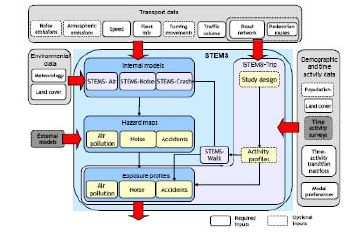
The main purpose of the HEARTS (Health Effects and Risk of Transport Systems) project was to develop and test an integrated impact assessment methodology to assess changes in exposure patterns and the related health effects due to different urban transport policies. Risks under consideration include: air pollution, noise and accidents. In order to develop an integrated approach a thorough review of different models relating to transport was undertaken, including in particular, models of road traffic, air pollution, noise, accidents, time-activity, exposure and health effects. Based on this review, existing models were selected for incorporation and use in HEARTS, and new (mainly microenvironmental) models developed where necessary. These models operate by assigning exposures to individuals or populations according to the proportion of their time spent in different micro-environments, each of which can be characterised by distributions of risk concentrations. The various models were linked through a Geographical Information System to provide an integrated assessment toolbox. In order to help develop the HEARTS methodology, field-test and validate the various tools, and demonstrate how the HEARTS approach might be used for policy assessment, three case studies were carried out in the cities of Leicester, Lille and Florence.
| ID | pc61 |
| Presentation | |
| Full Text | |
| Tags | accident analysis, pedestrians, urban mobility |













